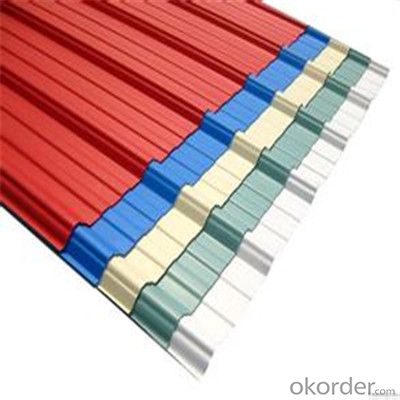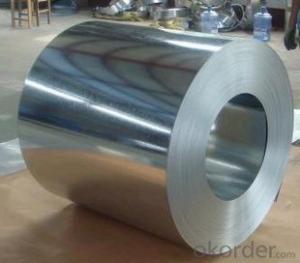Color Coated Galvanized Corrugated Steel Sheet
- Loading Port:
- Shanghai
- Payment Terms:
- TT OR LC
- Min Order Qty:
- 50 m.t.
- Supply Capability:
- 1000000 m.t./month
OKorder Service Pledge
OKorder Financial Service
You Might Also Like
Specification
Description of Prepainted Corrugated Iron Sheet:
1) Standard:JIS G3312,EN10169, GB/T-12754-2006
2) Thickness range:0.23mm-1.2mm
3) Width range:700mm-1250mm
4) Zinc Weight:70g/m2-300g/m2
5) Zinc spangle:Regular,Minimum
6) Coil weight: 3MT-10MT
Specifications of Prepainted Corrugated Iron Sheet:
1) Buildings and constructions: roofing, ceilings, gutters, venting lines, indoor decorations, window frames, etc.
2) Electrical appliances: computer shells, washing machines, refrigerators, dehumidifiers, video recorders, water heaters, etc.
3) Agricultural equipments: troughs, feeding tools, agricultural driers, irrigation channels, etc.
4) Vehicle parts: back-seat plates of buses and trucks, conveying systems, oil tanks, etc.
Features of Prepainted Corrugated Iron Sheet:
Galvanized steel coil products are mainly applied to building, light industry, automobile, agriculture and animal husbandry fishery. In construction industry, it is mainly used to produce anti-corrosion of industrial and civil building roof, roof grille.
Images of Prepainted Corrugated Iron Sheet:

FAQ:
1. What's the Delivery port?
The main ports are Qingdao and Tianjin, we also can deliver to other ports to meet your requirements
2. How long is the lead time?
Delivery time: 45 days after order confirmed.
3. What payment term do you accept?
Payment: T/T or L/C at sight.
- Q: What is the thickness of the steel sheets?
- The thickness of the steel sheets is typically measured in millimeters or gauge, and it can vary depending on the specific application or industry standards.
- Q: Are the steel sheets resistant to impact or denting?
- Yes, steel sheets are generally resistant to impact and denting due to their high strength and durability.
- Q: What are the common industries that use steel sheets?
- The common industries that use steel sheets include construction, automotive, aerospace, manufacturing, and appliance industries.
- Q: Can steel sheets be used for fire-rated doors?
- Yes, steel sheets can be used for fire-rated doors. In fact, steel is one of the most commonly used materials for fire-rated doors due to its high strength, durability, and fire-resistance properties. Steel sheets used in fire-rated doors are typically constructed with multiple layers of fire-resistant material, such as gypsum or mineral core, sandwiched between the steel sheets. This construction helps to prevent the spread of fire and smoke, providing a reliable barrier in the event of a fire. Additionally, steel is known for its structural integrity, making it a suitable choice for fire-rated doors that need to withstand high temperatures and pressure.
- Q: What is the typical price range for steel sheets?
- The typical price range for steel sheets can vary depending on factors such as size, thickness, grade, and market conditions. However, generally speaking, steel sheets can range in price from around $20 to $200 per sheet.
- Q: How do steel sheets perform in terms of scratch resistance?
- Steel sheets generally have good scratch resistance due to their strong and durable nature. They are less susceptible to scratching compared to other materials, making them suitable for various applications where scratching is a concern. However, the scratch resistance may vary depending on the specific type and finish of the steel sheet.
- Q: Can steel sheets be used for manufacturing doors or windows?
- Yes, steel sheets can be used for manufacturing doors or windows. Steel is a durable and strong material that is commonly used in construction, including for doors and windows. It provides strength, security, and can be designed in various styles to meet different aesthetic preferences.
- Q: Are the steel sheets resistant to vibration or shock?
- Steel sheets are generally resistant to vibration and shock due to their high strength and durability. Steel is known for its ability to withstand external forces like vibrations and shocks, thanks to its rigid nature. This allows steel to effectively absorb and distribute energy caused by vibrations or shocks, preventing any significant damage or deformation. In various industries, such as construction, automotive, and aerospace, steel sheets are commonly used because their resistance to vibrations and shocks is crucial. However, it's important to consider that the exact resistance of steel sheets to vibration or shock depends on factors like thickness, steel quality, and the specific magnitude and frequency of the vibrations or shocks.
- Q: Can steel sheets be customized in terms of size and thickness?
- Yes, steel sheets can be customized in terms of size and thickness to suit specific requirements and applications.
- Q: Can steel sheets be used for insulation in buildings?
- Steel sheets are not suitable for insulation in buildings because they have high thermal conductivity. This characteristic permits the easy transfer of heat and cold. Conversely, insulation materials like fiberglass, mineral wool, foam board, or cellulose are specifically designed to hinder the transfer of heat, cold, or sound. These materials are commonly employed in buildings as they possess low thermal conductivity and efficiently minimize heat loss or gain.
Send your message to us
Color Coated Galvanized Corrugated Steel Sheet
- Loading Port:
- Shanghai
- Payment Terms:
- TT OR LC
- Min Order Qty:
- 50 m.t.
- Supply Capability:
- 1000000 m.t./month
OKorder Service Pledge
OKorder Financial Service
Similar products
Hot products
Hot Searches
Related keywords




























